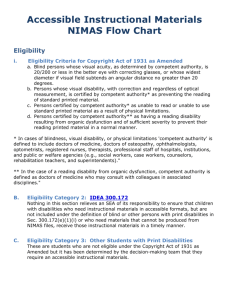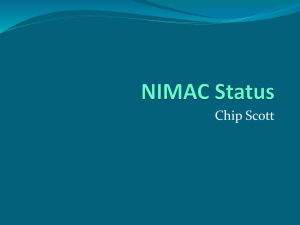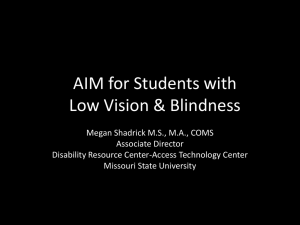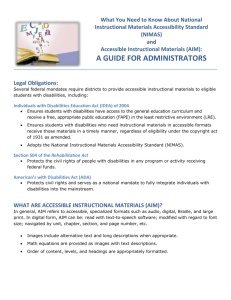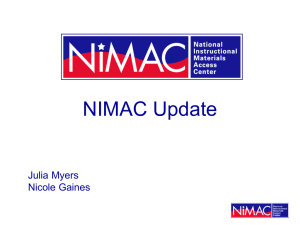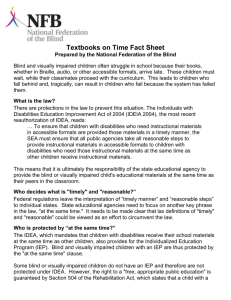nimas/nimac - Office of Superintendent of Public Instruction
advertisement
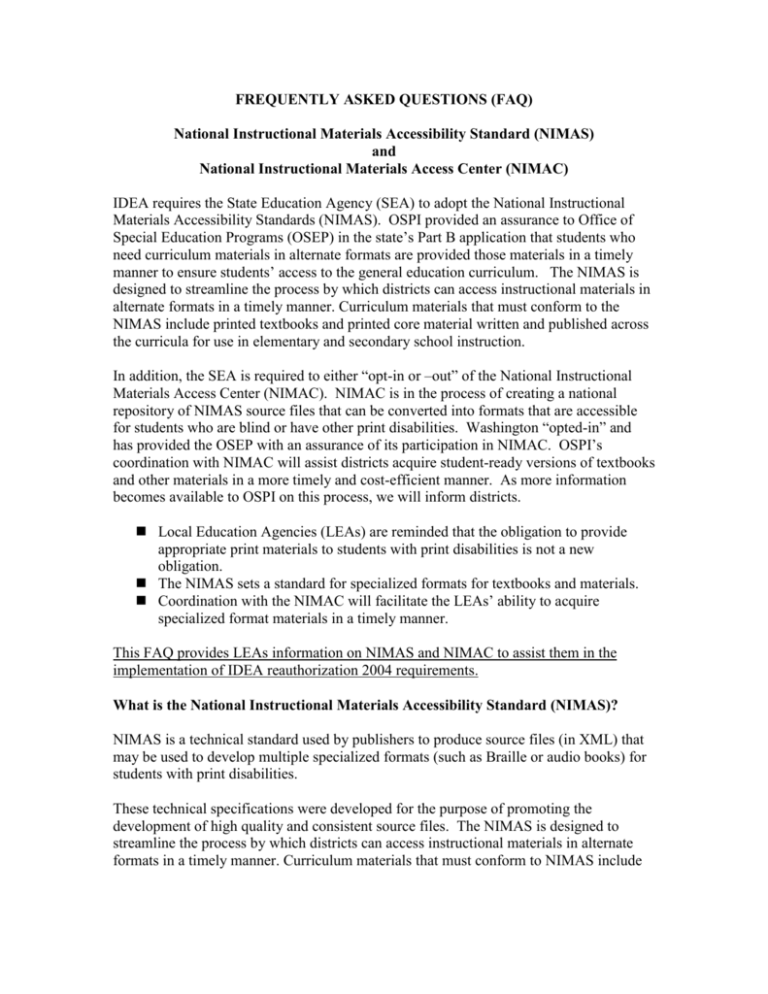
FREQUENTLY ASKED QUESTIONS (FAQ) National Instructional Materials Accessibility Standard (NIMAS) and National Instructional Materials Access Center (NIMAC) IDEA requires the State Education Agency (SEA) to adopt the National Instructional Materials Accessibility Standards (NIMAS). OSPI provided an assurance to Office of Special Education Programs (OSEP) in the state’s Part B application that students who need curriculum materials in alternate formats are provided those materials in a timely manner to ensure students’ access to the general education curriculum. The NIMAS is designed to streamline the process by which districts can access instructional materials in alternate formats in a timely manner. Curriculum materials that must conform to the NIMAS include printed textbooks and printed core material written and published across the curricula for use in elementary and secondary school instruction. In addition, the SEA is required to either “opt-in or –out” of the National Instructional Materials Access Center (NIMAC). NIMAC is in the process of creating a national repository of NIMAS source files that can be converted into formats that are accessible for students who are blind or have other print disabilities. Washington “opted-in” and has provided the OSEP with an assurance of its participation in NIMAC. OSPI’s coordination with NIMAC will assist districts acquire student-ready versions of textbooks and other materials in a more timely and cost-efficient manner. As more information becomes available to OSPI on this process, we will inform districts. Local Education Agencies (LEAs) are reminded that the obligation to provide appropriate print materials to students with print disabilities is not a new obligation. The NIMAS sets a standard for specialized formats for textbooks and materials. Coordination with the NIMAC will facilitate the LEAs’ ability to acquire specialized format materials in a timely manner. This FAQ provides LEAs information on NIMAS and NIMAC to assist them in the implementation of IDEA reauthorization 2004 requirements. What is the National Instructional Materials Accessibility Standard (NIMAS)? NIMAS is a technical standard used by publishers to produce source files (in XML) that may be used to develop multiple specialized formats (such as Braille or audio books) for students with print disabilities. These technical specifications were developed for the purpose of promoting the development of high quality and consistent source files. The NIMAS is designed to streamline the process by which districts can access instructional materials in alternate formats in a timely manner. Curriculum materials that must conform to NIMAS include printed textbooks and printed core material written and published across the curricula primarily for use in elementary and secondary school instruction. The source files are prepared using Extensible Markup Language (XML) to mark up the structure of the original content and provide a means for presenting the content in a variety of ways and styles. For example, once a NIMAS fileset has been produced for printed materials, the XML and image source files may be used to create Braille, large print, HTML versions, DAISY talking books using human voice or text-to-speech, audio files derived from text-to-speech transformations, and more. The various specialized formats created from NIMAS filesets may then be used to support a very diverse group of learners who qualify as students with print disabilities. What is the National Instructional Materials Access Center (NIMAC)? The NIMAC is located at the American Printing House for the Blind (AHP). The NIMAC was established by statute on December 3, 2005 and became operational December 3, 2006. The center is in the process of creating a national repository of NIMAS source files that can be converted into formats that are accessible for students who are blind or have other print disabilities. In Washington the conduit for accessing the NIMAC materials is the Instructional Resource Center located at the Washington State School for the Blind. The NIMAC will: Receive and maintain a catalog of print instructional materials prepared in NIMAS, as established by the Secretary, and made available to NIMAC by the textbook publishing industry, SEAs and LEAs. Develop, adopt and publish procedures to protect against copyright infringement, with respect to the print instructional material provided under Sections 612(a)(23) and 613(a)(6). [674(e)(2)] What does it mean for a state or LEA to “opt-in or opt-out” of coordinating with NIMAC? IDEA requires the State Education Agency (SEA) to adopt the National Instructional Materials Accessibility Standards (NIMAS). OSPI provided an assurance to OSEP in the state’s Part B application that students who need curriculum materials in alternate formats are provided those materials in a timely manner to ensure students’ access to the general education curriculum. The SEA is also required to either “opt-in or –out” of coordinating with the NIMAC. OSPI has chosen to coordinate with the NIMAC and has provided OSEP with an assurance of its participation in NIMAC. Opting to coordinate with NIMAC will help districts acquire student-ready versions of textbooks and other materials in a more timely and cost-efficient manner. The coordination includes support for the LEAs in their role as purchasers of print instructional materials. It requires publishers to prepare and on or before delivery of the printed instructional material provide NIMAC electronic files containing the contents of the print instructional materials using the NIMAS. For districts choosing to participate with the NIMAC, contracts with publishers executed on and after December 3, 2006 for textbooks and other printed core materials must include a provision that requires the publisher to produce NIMAS files and send them to the NIMAC. Curriculum publishers have been involved in discussions related to NIMAS and are well aware of the requirements. Opting-in to NIMAC does not negate the LEA’s choice of contracting directly with curriculum publishers for accessible student-ready versions of materials. OSPI has received guidance from OSEP in regards to non textbook adoption states, such as Washington. LEAs in these states are responsible for negotiating directly with publishers. IDEA does not require an LEA to coordinate with the NIMAC. However, IDEA does require each LEA to notify the SEA whether or not it will coordinate with the NIMAC. As part of the LEA’s IDEA funding application, the LEA indicates its choice to coordinate or not coordinate with the NIMAC (Federal Register Section 613(a)(6)). Whatever the district’s choice, each district is required to sign assurances that it will provide materials in alternate format in a timely manner for blind or other students with print disabilities. For districts that choose not to participate with NIMAC, each LEA may contract with curriculum publishers directly to purchase accessible student-ready versions. If the student-ready versions exist, they may be made available at a significant cost to LEAs. Be advised that publishers typically do not have such versions for sale. What steps will the LEA need to take to meet the IDEA requirements? The LEA should take the following steps: Under Section II, Assurances, of the LEA application for federal funds the district must indicate whether it will or will not coordinate with NIMAC (Assurance #21). Whether the LEA opts to coordinate or not coordinate with NIMAC, it ensures each child who requires instructional materials in an alternate format will receive these in a timely manner (613(a)(6)). Special note: OSPI recommends that districts elect to coordinate with NIMAC as the national effort to centralize the distribution of instruction materials in alternate formats will help ensure timely provision of these materials to students. Districts choosing to coordinate with NIMAC will be required to add language in contracts with publishers that they must produce NIMAS files and send them to NIMAC. OSPI is providing model contract language adopted from the state of Massachusetts for possible use by districts in their negotiations with publishers. The model language is included below: “By agreeing to deliver the materials marked with “NIMAS” on this contract or purchase order, the publisher agrees to submit on or before _____/____/____ a valid NIMAS file set to the NIMAC at the American Printing House for the Blind, Inc. Should the vendor be a distributor of the materials and not the publisher, the distributor agrees to immediately notify the publisher of its obligation to submit NIMAS file sets of the purchased projects to the NIMAC. The files will be used for the production of alternate formats as permitted under the law for students with print disabilities.” How will students receive accessible materials? The delivery systems that already exist will remain available. For materials dated 2007: LEAs will maintain their accounts with the Instructional Resource Center (IRC) located at the Washington State School for the Blind to coordinate access with the NIMAC. The IRC will be able to access electronic files from NIMAC for suitable conversion to specialized formats. OSPI provides funding to facilitate the partnership between the IRC and LEAs. For more information on how the IRC can support the LEA in acquiring appropriate textbooks and materials, contact Colleen Lines at the IRC. Her contact information is (360) 696-6321 Ext. 183 or colleen.lines@wssb.wa.gov. Are publishers aware of the new IDEA requirements? Yes, publishers have been part of the discussions concerning the NIMAS and the role of NIMAC. They are expecting to see contract language which ensures they will submit NIMAS file sets of the purchased materials to the NIMAC. Publishers will produce each text in a singe file format and deliver it to one location – the NIMAC – for distribution to authorized entities and for further enhancement by authorized users. As long as a publisher possesses print rights are given an exemption to copyright law to facilitate the transfer of NIMAS-conformant files directly to the NIMAC. This copyright protection applies only to the files provided to the NIMAC and not, for example, to files that may be provided directly to LEAs. What disabilities qualify a student to be served with NIMAS-derived accessible textbooks? IDEA 2004 includes a definition of students who may be provided with accessible textbooks created with NIMAS-conformant files from the NIMAC. That definition, used with the legislation, is “blind or other persons with print disabilities.” WAC 392-172A06040 defines blind persons or other persons with print disabilities to mean “students served under this part who may qualify to receive books and other publications produced in specialized formats in accordance with the act entitled “An Act to provide books for adult blind,” approved March 3, 1931, 2 U.S.C. 135a. Where may one obtain more information? The following provides information on NIMAS and NIMAC: CAST NIMAS Centers: http://nimas.cast.org NIMAS FAQ: http://nimas.cast.org/about/faq/index.html NIMAC at APH: http://www.nimac.us NIMAC FAQ: http://www.nimac.us/faq.html Who can I contact within the state for assistance? Colleen Lines, NIMAS/NIMAC State Coordinator, Instructional Resource Center (IRC) located at the Washington State School for the Blind, (360) 696-6321 Ext. 183 or colleen.lines@wssb.wa.gov . Lou Colwell, NIMAS/NIMAC liaison, Office of Superintendent of Public Instruction (OSPI), (360) 725-6075 or MaryLouise.Colwell@k12.wa.us . July, 2007
